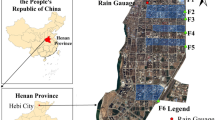Abstract
Global climate change and urbanization development have changed the hydrological environment dramatically. Flood control, non-point source pollution control, and comprehensive utilization of water resources are facing new challenges. On the basis of the Storm Water Management Model (SWMM), an approach for design rainfall pattern selection in precipitation data-lacked region containing model establishing, response analysis and design rainfall pattern screening was put forward. And the responses of the hydrologic, hydraulic and environmental of 2-commercial community mode are explored by using a simulation analysis under different rainfall patterns in this study. Based on the worst principle, the Chicago rainfall pattern was selected for the above-mentioned evaluation indexes at different reoccurrence periods. Results showed that, (1) in traditional development (TD), the values of surface runoff, peak flow and depth of outlet, and total pollution loading were at their maximum at the Chicago rainfall pattern; and in low-impact development (LID), the reduction rates of surface runoff and total pollution loading were at their minimum at the Huff4 rainfall pattern, and the reduction rate of peak flow was at its minimum at the P&C rainfall pattern; then design storm patterns at different simulation targets were obtained. (2) For the Chicago rainfall pattern, the reduction rates of various evaluation indexes decreased while the reoccurrence period increased, and the reduction rate of peak flow was more sensitive to high reoccurrence period rainfall than surface runoff. (3) After the setting of LID measures, the control effect of storm water and non-point source pollution gathered better results from the increase of permeable area and the change of microtopography, as well as from the physical and biological action. This study will provide a reference for the selection of design storm pattern at different simulation targets in regions with deficient rainfall data.







Similar content being viewed by others
References
Aryal SK, Ashbolt S, Mcintosh BS, Petrone KP, Maheepala S, Chowdhury RK, Gardener T, Gardiner R (2016) Assessing and mitigating the hydrological impacts of urbanisation in semi-urban catchments using the storm water management model. Water Resour Manag 30:1–18
Barco J, Wong KM, Stenstrom MK (2008) Automatic calibration of the U.S. EPA SWMM model for a large urban catchment. J Hydraul Eng 134(4):466–474
Dou J, Wang Y, Bornstein R, Miao S (2014) Observed spatial characteristics of Beijing urban- climate impacts on summer thunderstorms. J Appl Meteorol Climatol 54(1):94–105
Huff FA (1967) Time distribution of rainfall in heavy storms. Water Resour Res 3(4):1007–1019
Jiang R, Gan TY, Xie J, Wang N (2014) Spatiotemporal variability of Alberta’s seasonal precipitation, their teleconnection with large-scale climate anomalies and sea surface temperature. Int J Climatol 34(9):2899–2917
Kuo CC, Gan TY, Hanrahan JL (2014) Precipitation frequency analysis based on regional climate simulations in Central Alberta. J Hydrol 510(1):436–446
Lenhart T, Eckhardt K, Fohrer N, Frede HG (2002) Comparison of two different approaches of sensitivity analysis. Phys Chem Earth 27(9):645–654
Li JK, Zhang B, Mu C, Chen L (2018) Simulation of the hydrological and environmental effects of a sponge city based on MIKE FLOOD. Environ Earth Sci 77(2):32
Mao XH, Jia HF, Yu SL (2017) Assessing the ecological benefits of aggregate LID-BMPs through modelling. Ecol Model 353:139–149
Nguyen VT, Desramaut N, Nguyen TD (2010) Optimal rainfall temporal patterns for urban drainage design in the context of climate change. Water Sci Technol 62(5):1170–1176
Onof C, Arnbjergnielsen K, Burlando P (2009) Quantification of anticipated future changes in high resolution design rainfall for urban areas. Atmos Res 92(3):350–363
Owrangi AM, Lannigan R, Simonovic SP (2014) Interaction between land-use change, flooding and human health in metro Vancouver, Canada. Nat Hazards 72(2):1219–1230
Pilgrim DH, Cordery I (1975) Rainfall temporal patterns for design floods. J Hydraul Div 101(6):81–95
Rossman LA (2015) Storm water management model User's manual version 5.1. U.S. Environmental Protection Agency, Washington, DC
Yao L, Chen L, Wei W (2016) Assessing the effectiveness of imperviousness on stormwater runoff in micro urban catchments by model simulation. Hydrol Process 30(12):1836–1848
Acknowledgments
This research was financially supported by the Natural Science Foundation of Shaanxi Province (2015JZ013) the key research and development project of Shaanxi Province (2017ZDXM-SF-073).
Author information
Authors and Affiliations
Corresponding author
Ethics declarations
Conflict of Interest
None.
Rights and permissions
About this article
Cite this article
Li, J., Deng, C., Li, H. et al. Hydrological Environmental Responses of LID and Approach for Rainfall Pattern Selection in Precipitation Data-Lacked Region. Water Resour Manage 32, 3271–3284 (2018). https://doi.org/10.1007/s11269-018-1990-9
Received:
Accepted:
Published:
Issue Date:
DOI: https://doi.org/10.1007/s11269-018-1990-9




